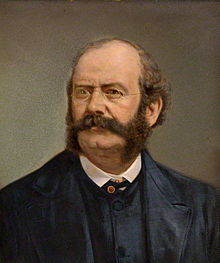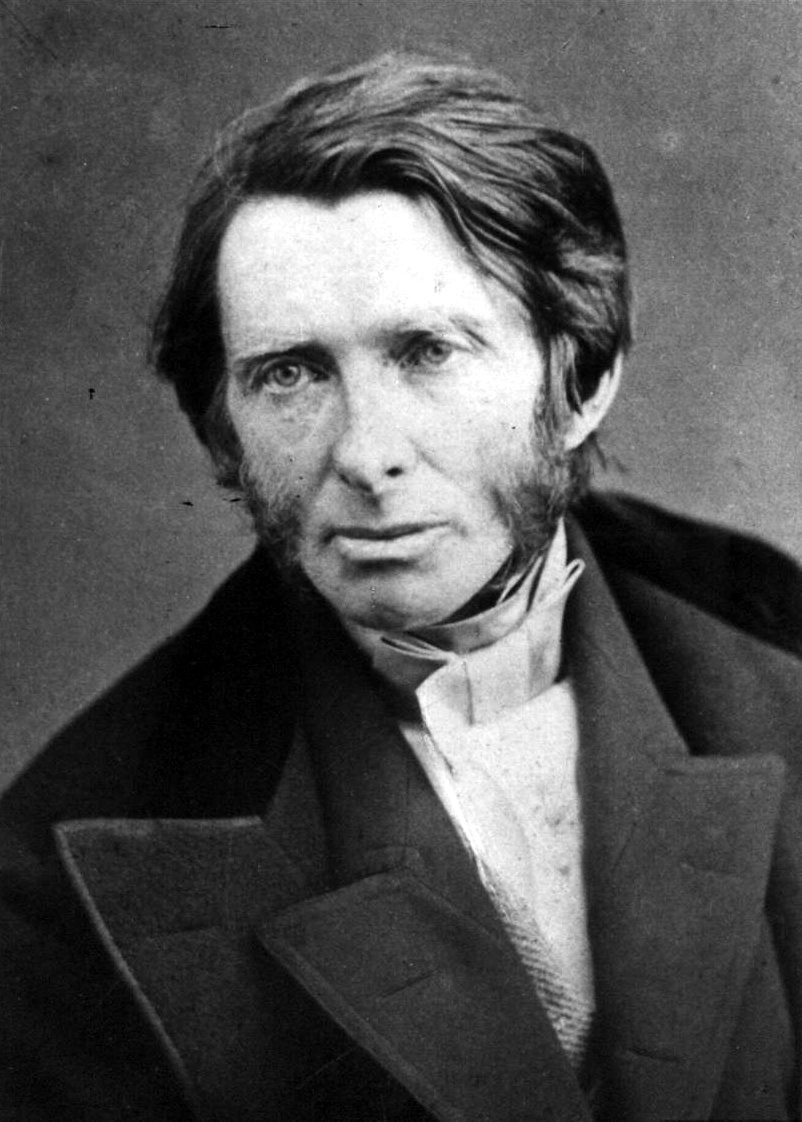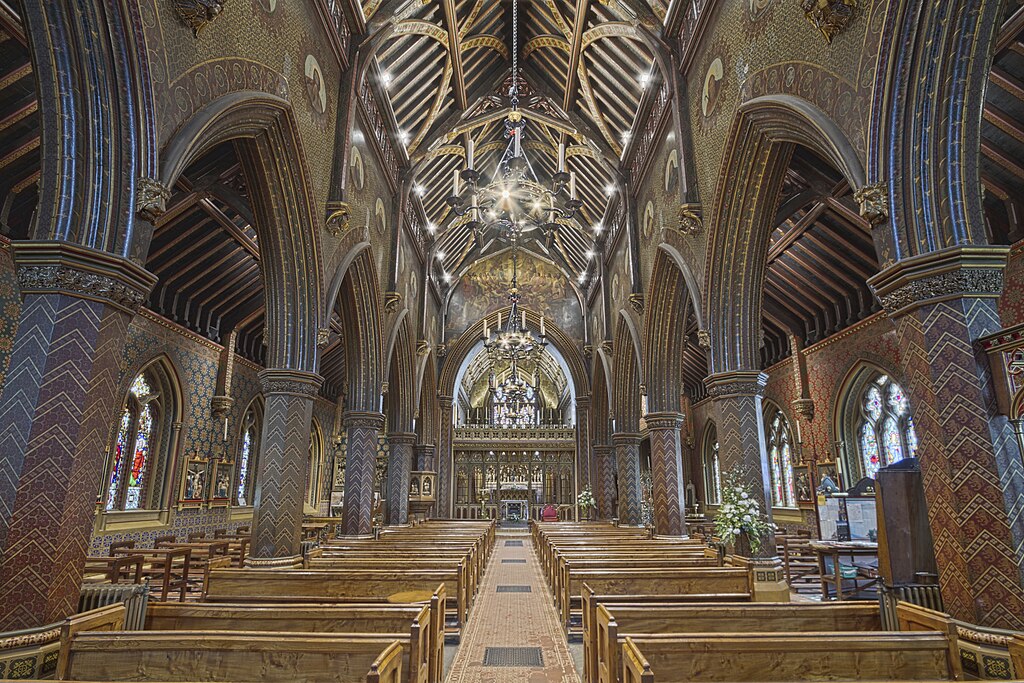The Gothic trend started all the way back in medieval times when buildings were created in order to impress those of an elite, higher status within the hierarchy. However, as the 1800’s started the take place, an industrialisation of architecture moved in which forced those with a more traditional acquired taste try to revive this gothic and medieval approach to architect. Thus formerly creating the term ‘Gothic Revival’ with the intention of bringing a meaning back to the architecture of England. George Gilbert Scott can be seen to have been one of the minds behind the introduction of gothic revivalism and the renovation of many Churches of England.
Revivalists in the 19th century were arguably captivated with creating designs that were based on form and pattern. Therefore, Gothic revival buildings consisted of high pitched roofs, tall spires, pointed arches, quatrefoils, cluster columns and holy crosses communicating a fanciful and sacred vision of religion and medieval romance during this post Middle Ages period. This type of architecture became so stylish in the 1800’s it saw wealthy millionaires and romanticists such as William Beckford take on the structured idea and create the country mansion, Fonthill House alongside many other famous Gothic Revivalists such as John Ruskin, William Burges and Augustus Pugin who all contributed to the creation of architectures with a Gothic formation.
Gothic revival then went on to not just become a trend for architecture, but one that influenced the way people chose to dress, the fonts used in newspapers, literature, artwork, painted furniture and it was even translated onto the structure of garden benches. Furthermore, buildings that house the British Government such as the House of Parliament can also be seen to have once been buildings associated with Gothic Revival.
Arguably, Gothic Revival even had some control over Lewis Carroll’s fictional story of 'Alice's adventures in Wonderland' in 1865 as some of the illustrations by John Tenniel for the novel were highly influenced by the concept of gothic whimsical art prints during the 19th Century.
Illustrations by John Tenniel for the 1865 classic novel 'Alice's Adventures in Wonderland' by Lewis Carroll.
The term still has great impact in today's 21st century as subcultures such as 'Goths' are still very apparent and characterise themselves by wearing heavy eyeliner and black Victorian styled attire.
Famous Gothic Revivalists:
William Burges (1827 - 1881)
Burges was a designer, architecture and writer however, in contrast to many other revivalists' Burges took inspiration from the arts of the Islamic world and those that were being created in Eastern Asia therefore, filling his imagination with many ideas for the construction of Gothic architecture in Britain. Burges was most famously known for his the design of two of the most magnificent Gothic Revival buildings ever; Cardiff Castle and Castle Coch. His elaborative exterior work for both Castles was arguably built for the Marquis of Bute, and was inspired by other medieval castles. However, similarly to John Ruskin, Burges opted for a different cultural and national approach to his work and took inspiration from Europe and French constructions for this architectural project.


Washstand by Burges

Cardiff Castle's Arab room

William Burges' design for the Summer Smoking room of Cardiff Castle.
John Ruskin (1819 - 1900)
John Ruskin is probably one of the most famous Gothic Revivalist's to date and was also famous for his criticism over art during the 19th century. His first interest in Gothic architecture took place during his travels across Europe where was inspired by colourful buildings and the decorations that they obtained. Through his work, he intended to travel back to the Middle Ages through the recreation of architectures and spiritual values that commenced during this period. His books 'The Seven Lamps of Architecture' and 'The Stones of Venice' can be seen to have had great impact on the Gothic Revival phase.
 .
.
.jpg)
John Ruskin art print 1849 John Rukin's The Nature of Gothic printed in 1892
during the Arts and Craft's movement
Augustus Welby Northmore Pugin (1812 - 1852)
A.W.N Pugin was another theorist during the 19th century whose work had been influence by the theory of Gothic Revival. Contrasts (1836) and 'True Principle of Christian Architecture' are both pieces of literature which can be seen as examples demonstrating the exploration of the style. Furthermore, Pugin also assisted with the development of the architecture 'Palace of Westminster' between 1837 and 1867 alongside the designer, Charles Barry. This building is known as one of the most dramatic Gothic Revival architectures in the world.
He was also known to use medieval art as inspiration during the creation of St Giles Catholic Church in Cheadle, Staffordshire.


Palace of Westminster constructed between 1837 and 1867.
The largest and most dramatic Gothic Revival building in the world. (designed and developed by Charles Barry and A.W.N Pugin.)

St Giles Catholic Church in Cheadle, Staffordshire.
Examples of Gothic Revival Architecture:
Some of the architects designed by 19 century Gothic Revivalists still stands today such as St Pancras Station, Tower Bridge, The Houses of Parliament and Scott's Monument. Unfortunately, William Beckford's Fonthill Abbey only stood for approximately just over twenty years collapsing in 1825.

Fonthill Abbey

Tower Bridge, London

St Pancras Station, London
Scott's Monument, Edinburgh
Gothic Revival as a Fashion Trend: During the 19th Century Gothic Revivalists were followers of the Medieval trend, therefore, the century saw many individuals dress up in historical costume for events and parties to embrace the Middle Ages fashion.
However, fast forwarded two centuries later, the Gothic Revival trend has been romanticised yet again and has become a style that is continuously regurgitated onto the runway. However, in an extremely contemporary and fashionable way. The likes of Alexander McQueen, Alberta Feretti and Rodarte have all be known to communicate the 19th century vamped-up dark glam look throughout their collections.
(All of the outfits I have featured below are fuelled by great imagination and contain inquisitive designs, therefore, I would definitely recommend having a look at what the rest of the collection looked like!)
Alexander McQueen A/W 15-16


Alberta Feretti A/W 15-16


Rodarte A/W 15-16


Dolce and Gabbana A/W 13-14

No comments
Post a Comment